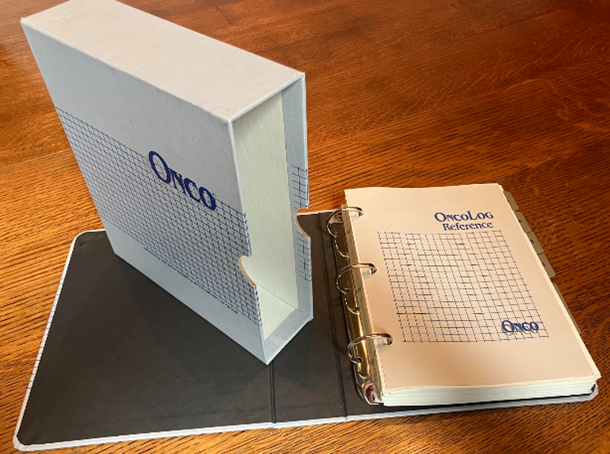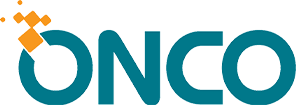Did you know ONCO has been around for over 40 years? In this series, we take a stroll down memory lane — sharing how our tech has grown, the awesome people who’ve made an impact, and the partners who’ve been with us along the way. Thank you to everyone who has been part of this journey!
ONCOLog’s Origins: From Index Cards to Innovation
It all began in a moment of quiet observation in 1970 at the Community Hospital of the Monterey Peninsula (CHOMP) Carmel, California. There, a physics professor visiting from the U.S. Naval Postgraduate School (Dr. Ted Williamson, Onco’s Medical Director) witnessed a registry secretary recording cancer patient detail on 4×6 index cards—the standard method of cancer data collection at the time. That experience planted the seed for what would one day become ONCOLog.
A Pre-Digital Experiment in Cancer Treatment Data
Intrigued by the potential of structured data in cancer care, Ted created one of the first digital registries at CHOMP in 1972, using IBM punch cards and mainframes borrowed from the military and McGraw-Hill. Despite the lack of hospital computing infrastructure, he built a basic system to track radiation oncology patients, generate survival curves, and produce custom reports—an early demonstration of what cancer data could truly offer.
The Birth of REGIST and a Broader Vision
In 1972 CHOMP hired its first specialty-trained Radiation Oncologist to staff the department. During that first year the patient load increased over 300% from 15 to 50 patients. Dr. Williamson was asked to compile data to support the solicitation of desperately needed funds for expanding the department.
By 1979, supported by collaboration with ADAC Laboratories, (Sunnyvale, California) led to Teds’ creation of REGIST, a radiation oncology registry system designed for their DEC 11-03 minicomputer. Though the interface was basic, REGIST allowed ad hoc reporting and hundreds of user-defined data fields, features that were revolutionary for the time. It became part of every ADAC treatment planning system package.
A pivotal moment came in 1982 at the 13th International Cancer Conference in Seattle, Washington — when REGIST caught the attention of Dr. Charles Smart, Director of the Cancer Division at the Commission on Cancer. His encouragement inspired the formal creation of ONCO and the development of a more generalized registry system that would soon evolve into ONCOLog.
Bootstrapped Technology: Floppy Disks and Flat Files
The early technical implementation of ONCOLog in DOS was a story of pragmatism and creativity. Without networked infrastructure or cloud storage, floppy disks became the primary medium for data storage, backups, and transfers. Magnetic tapes were also used to import data from external sources. The flat file database design meant each patient diagnosis was stored as a single record—an efficient structure, though simplistic by today’s standards.
Data was often entered and moved using 5.25-inch floppy disks, with files shared between facilities manually. These constraints influenced the design philosophy: minimal hardware requirements, compact files, and tools that could operate on the limited resources of an AT&T 6300 microcomputer running DOS.

The DOS ONCOLog user manual.
“.. by this time we’ve got 120 hospitals each needing a big stack of floppy disks, each going out to a place (hospital) where there may have been no IT director..” commented Dr. Williamson.
Yet even within these limitations, ONCOLog supported powerful custom fields and reporting capabilities, making it more advanced than many larger competitors.
From Family Startup to First Clients
ONCOLog’s early development was a true family effort— Ted Williamson’s wife, Eileen Lane Williamson, helped incorporate the company, solidify financial backing, secured office space and began hiring staff. Their teenage children assisted with coding and case abstraction – his daughter once abstracting 5,000 cases over a summer break, he shared. The first DOS-based version of ONCOLog launched in 1986 at Salem Health, followed by other clients throughout the Northwest. Data migration was challenging due to the lack of standards, but ONCOLog quickly established a reputation for flexibility and reliability.

Ted Williamson, Medical Director and Founder of ONCO, with his wife Eileen and their two children.
Innovating Beyond the Basics
In 1996, a partnership with Varian Corporation enabled ONCOLog to transition to Windows. The team built a registry platform that offered unlimited custom fields and multi-facility database support—capabilities that remain industry-leading today. Unlike competitors, ONCOLog unified data across facilities without creating fragmented systems.
A lot can happen in 20 years – a complete digital evolution from index cards to internet.
Stay tuned for part 2 of our series, “40 years of ONCO” as we dive into the Y2K era.


